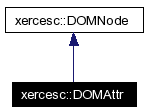
DOMAttr class refers to an attribute of an XML element.
More...
#include <DOMAttr.hpp>
Inheritance diagram for xercesc::DOMAttr:

Public Member Functions | |
Destructor | |
| virtual | ~DOMAttr () |
| Destructor. | |
Functions introduced in DOM Level 1 | |
| virtual const XMLCh * | getName () const =0 |
| Returns the name of this attribute. | |
| virtual bool | getSpecified () const =0 |
| Returns true if the attribute received its value explicitly in the XML document, or if a value was assigned programatically with the setValue function. | |
| virtual const XMLCh * | getValue () const =0 |
| Returns the value of the attribute. | |
| virtual void | setValue (const XMLCh *value)=0 |
| Sets the value of the attribute. | |
Functions introduced in DOM Level 2. | |
| virtual DOMElement * | getOwnerElement () const =0 |
The DOMElement node this attribute is attached to or null if this attribute is not in use. | |
Functions introduced in DOM Level 3. | |
| virtual bool | isId () const =0 |
| Returns whether this attribute is known to be of type ID or not. | |
| virtual const DOMTypeInfo * | getSchemaTypeInfo () const =0 |
| Returns the type information associated with this attribute. | |
Protected Member Functions | |
Hidden constructors | |
| DOMAttr () | |
| DOMAttr (const DOMAttr &other) | |
DOMAttr class refers to an attribute of an XML element.
Typically the allowable values for the attribute are defined in a documenttype definition.
DOMAttr objects inherit the DOMNode interface, but since attributes are not actually child nodes of the elements they are associated with, the DOM does not consider them part of the document tree. Thus, the DOMNode attributes parentNode, previousSibling, and nextSibling have a null value for DOMAttr objects. The DOM takes the view that attributes are properties of elements rather than having a separate identity from the elements they are associated with; this should make it more efficient to implement such features as default attributes associated with all elements of a given type. Furthermore, attribute nodes may not be immediate children of a DOMDocumentFragment. However, they can be associated with DOMElement nodes contained within a DOMDocumentFragment. In short, users of the DOM need to be aware that DOMAttr nodes have some things in common with other objects inheriting the DOMNode interface, but they also are quite distinct.
|
|
|
|
|
|
|
|
Destructor.
|
|
|
Returns the name of this attribute.
|
|
|
The
|
|
|
Returns the type information associated with this attribute.
|
|
|
Returns true if the attribute received its value explicitly in the XML document, or if a value was assigned programatically with the setValue function. Returns false if the attribute value came from the default value declared in the document's DTD.
|
|
|
Returns the value of the attribute. The value of the attribute is returned as a string. Character and general entity references are replaced with their values.
|
|
|
Returns whether this attribute is known to be of type ID or not. When it is and its value is unique, the ownerElement of this attribute can be retrieved using getElementById on DOMDocument.
|
|
|
Sets the value of the attribute. A text node with the unparsed contents of the string will be created.
|
 1.3.9.1
1.3.9.1